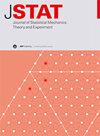How motility affects Ising transitions
IF 1.9
3区 物理与天体物理
Q2 MECHANICS
Journal of Statistical Mechanics: Theory and Experiment
Pub Date : 2024-09-16
DOI:10.1088/1742-5468/ad685b
引用次数: 0
Abstract
We study a lattice gas (LG) model of hard-core particles on a square lattice experiencing nearest neighbour attraction J. Each particle has an internal orientation, independent of the others, that point towards one of the four nearest neighbour and it can move to the neighbouring site along that direction with the usual metropolis rate if the target site is vacant. The internal orientation of the particle can also change to any of the other three with a constant rate The dynamics of the model in reduces to that of the LG which exhibits a phase separation transition at particle density and temperature when the strength of attraction J crosses a threshold value This transition belongs to Ising universality class (IUC). For any finite the particles can be considered as attractive run-and-tumble particles (RTPs) in two dimensions with motility We find that RTPs also exhibit a phase separation transition, but the critical interaction required is which increases monotonically with increased motility It appears that the transition belongs to IUC. Surprisingly, in these models, motility impedes cluster formation process necessitating higher interaction to stabilize microscopic clusters. Moreover, MIPS like phases are not found when J = 0.运动如何影响伊辛转换
每个粒子都有一个独立于其他粒子的内部方向,指向四个近邻中的一个,如果目标位置空闲,粒子可以以通常的大都会速率沿该方向移动到邻近位置。粒子的内部方向也可以以恒定的速率改变为其他三个方向中的任何一个。该模型的动力学原理简化为 LG 的动力学原理,当吸引力强度 J 跨过临界值时,粒子密度和温度会出现相分离转变。我们发现,RTPs 也会出现相分离转变,但所需的临界相互作用是随着运动性的增加而单调增加的。令人惊讶的是,在这些模型中,运动阻碍了团簇的形成过程,因此需要更高的相互作用来稳定微观团簇。此外,当 J = 0 时,没有发现类似 MIPS 的阶段。
本文章由计算机程序翻译,如有差异,请以英文原文为准。
求助全文
约1分钟内获得全文
求助全文
来源期刊
CiteScore
4.50
自引率
12.50%
发文量
210
审稿时长
1.0 months
期刊介绍:
JSTAT is targeted to a broad community interested in different aspects of statistical physics, which are roughly defined by the fields represented in the conferences called ''Statistical Physics''. Submissions from experimentalists working on all the topics which have some ''connection to statistical physics are also strongly encouraged.
The journal covers different topics which correspond to the following keyword sections.
1. Quantum statistical physics, condensed matter, integrable systems
Scientific Directors: Eduardo Fradkin and Giuseppe Mussardo
2. Classical statistical mechanics, equilibrium and non-equilibrium
Scientific Directors: David Mukamel, Matteo Marsili and Giuseppe Mussardo
3. Disordered systems, classical and quantum
Scientific Directors: Eduardo Fradkin and Riccardo Zecchina
4. Interdisciplinary statistical mechanics
Scientific Directors: Matteo Marsili and Riccardo Zecchina
5. Biological modelling and information
Scientific Directors: Matteo Marsili, William Bialek and Riccardo Zecchina

 求助内容:
求助内容: 应助结果提醒方式:
应助结果提醒方式:


